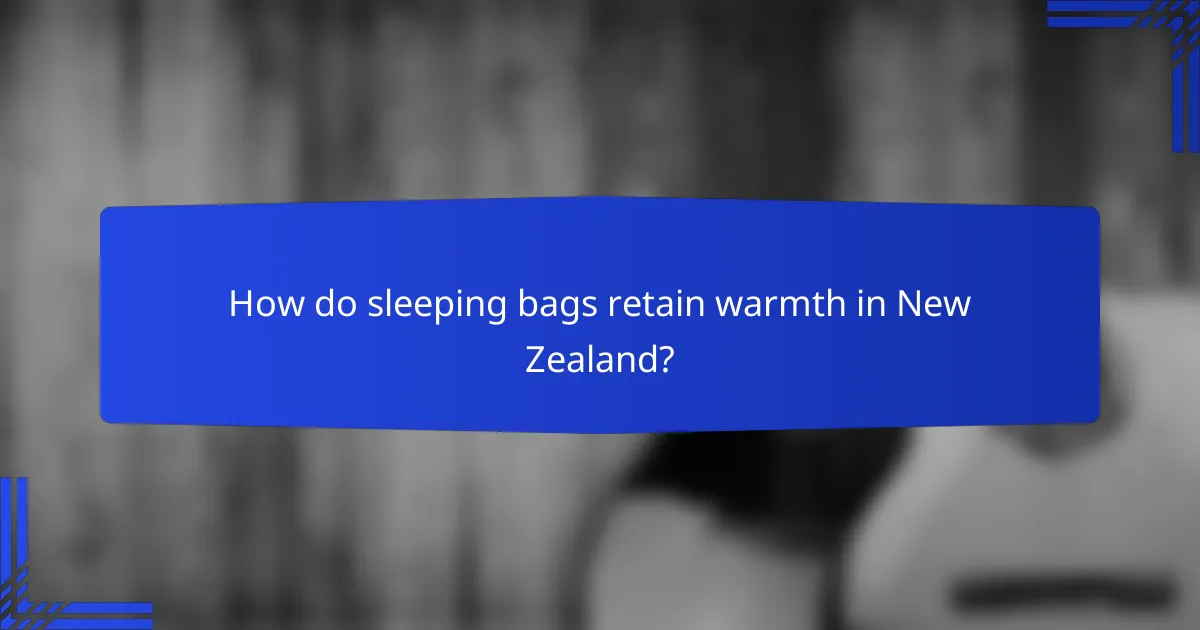Sleeping bags are essential for outdoor comfort, designed to retain warmth through effective insulation and thoughtful features. In New Zealand’s diverse climate, choosing a lightweight and compressible sleeping bag is vital for easy transport and optimal warmth retention during your adventures.

How do sleeping bags retain warmth in New Zealand?
Sleeping bags retain warmth through effective insulation, temperature ratings, and thoughtful design features. In New Zealand’s varied climate, selecting the right sleeping bag is crucial for maintaining comfort during outdoor activities.
Insulation materials
Insulation materials play a vital role in warmth retention. Common options include down and synthetic fibers. Down is lightweight and compressible, providing excellent warmth-to-weight ratios, while synthetic materials perform better in wet conditions and are typically easier to care for.
When choosing insulation, consider the climate and your activity level. For colder, drier conditions, down may be preferable, whereas synthetic insulation is often recommended for damp environments like New Zealand’s coastal areas.
Temperature ratings
Temperature ratings indicate the lowest temperature at which a sleeping bag can keep a user warm. Ratings can vary significantly, typically ranging from around -10°C to +10°C. It’s important to select a bag that suits the expected overnight temperatures during your trip.
In New Zealand, a sleeping bag rated for 0°C to -5°C is generally suitable for most winter camping scenarios, while a bag rated for +5°C to +10°C may suffice for summer outings. Always consider personal comfort levels and whether you tend to sleep warm or cold.
Design features
Design features such as hood design, draft collars, and zippers enhance warmth retention. A well-designed hood can trap heat, while draft collars prevent cold air from entering the bag. Additionally, a full-length zipper allows for ventilation when needed.
Look for features that cater to your specific needs. For instance, if you plan to camp in very cold conditions, prioritize bags with adjustable hoods and draft collars. Conversely, for milder weather, a lighter bag with fewer features may be more suitable.

What lightweight sleeping bags are best for camping?
For camping, the best lightweight sleeping bags combine warmth retention, compressibility, and a design that facilitates easy transport. Top options include the Sea to Summit Spark Sp I, Big Agnes Fish Hawk, and Therm-a-Rest Hyperion, each offering unique features tailored for outdoor enthusiasts.
Sea to Summit Spark Sp I
The Sea to Summit Spark Sp I is an ultra-lightweight sleeping bag designed for backpackers seeking minimal weight without sacrificing warmth. Weighing around 400 grams, it features a high-quality down insulation that provides excellent warmth retention, making it suitable for temperatures as low as 0°C.
This sleeping bag compresses down to a small size, fitting easily into a backpack. Its design includes a tapered shape that enhances thermal efficiency while reducing bulk, making it a top choice for those prioritizing weight savings on long hikes.
Big Agnes Fish Hawk
The Big Agnes Fish Hawk sleeping bag is known for its balance of comfort and lightweight design, weighing approximately 1,200 grams. It features synthetic insulation, which retains warmth even when damp, making it ideal for unpredictable weather conditions often encountered while camping.
This bag includes a unique integrated sleeping pad sleeve, ensuring that your pad stays in place throughout the night. With a temperature rating around -5°C, it offers a cozy option for cooler nights without the added weight of heavier alternatives.
Therm-a-Rest Hyperion
The Therm-a-Rest Hyperion is a premium lightweight sleeping bag that excels in warmth-to-weight ratio, weighing about 500 grams. It utilizes high-quality down insulation, providing excellent warmth retention for temperatures as low as -3°C, making it suitable for three-season camping.
Its compressible design allows it to pack down small, fitting into most backpacks with ease. The Hyperion also features a unique design that enhances loft and minimizes cold spots, ensuring a comfortable night’s sleep in various conditions.

How to choose a compressible sleeping bag?
To choose a compressible sleeping bag, consider its weight, insulation type, and pack size. A good balance between warmth retention and lightweight design will ensure easy transport without sacrificing comfort during your outdoor adventures.
Pack size comparison
When comparing pack sizes, look at the dimensions when the sleeping bag is compressed. Most compressible sleeping bags can fit into a stuff sack that ranges from about 10 to 20 liters. Smaller bags are ideal for backpacking, while larger ones may be better suited for car camping.
For example, a high-quality down sleeping bag typically compresses smaller than a synthetic one, making it a preferred choice for long hikes. Always check the manufacturer’s specifications for exact pack sizes.
Material impact on compressibility
The material of a sleeping bag significantly affects its compressibility. Down insulation is known for its excellent warmth-to-weight ratio and compressibility, often packing down to a fraction of its size. In contrast, synthetic materials tend to be bulkier but offer better moisture resistance.
When selecting a sleeping bag, consider the trade-offs between warmth retention and compressibility. For instance, a down bag may be more compact but could be less effective in wet conditions compared to a synthetic alternative.
Storage recommendations
Proper storage of your sleeping bag is crucial for maintaining its compressibility and insulation properties. Always store your bag uncompressed in a large cotton or mesh sack to prevent the insulation from losing its loft. Avoid leaving it compressed for extended periods.
Before your next trip, check for any dirt or moisture on the bag. If necessary, follow the manufacturer’s cleaning instructions to ensure optimal performance. Regular maintenance will prolong the life of your sleeping bag and keep it ready for your adventures.

What are the key features of sleeping bags for New Zealand conditions?
Sleeping bags designed for New Zealand conditions prioritize warmth retention, lightweight design, and compressibility to accommodate varying climates and outdoor activities. These features ensure comfort and practicality for campers and hikers in diverse environments.
Water resistance
Water resistance is crucial for sleeping bags used in New Zealand, where sudden rain can occur. Look for bags made with water-resistant materials or treated with durable water repellent (DWR) finishes to keep moisture at bay. A water-resistant sleeping bag will help maintain warmth and comfort during unexpected weather changes.
Consider the bag’s construction as well; features like waterproof zippers and draft collars can enhance water resistance. It’s advisable to store your sleeping bag in a waterproof stuff sack when not in use to protect it from damp conditions.
Durability
Durability is essential for sleeping bags, especially for those who frequently camp or hike in rugged New Zealand terrains. Fabrics like ripstop nylon or polyester are commonly used for their strength and resistance to wear and tear. A durable sleeping bag can withstand the rigors of outdoor use while maintaining its insulating properties.
Check for reinforced seams and high-quality zippers, as these areas are often the most vulnerable. Investing in a well-constructed sleeping bag can save you money in the long run by reducing the need for replacements.
Ventilation options
Ventilation options in sleeping bags are important for regulating temperature during varying weather conditions in New Zealand. Look for bags with features like adjustable hoods, zippered vents, or mesh panels that allow for airflow. These features help prevent overheating during warmer nights or when engaging in physical activities.
When selecting a sleeping bag, consider your typical camping environment. If you often camp in humid areas, a bag with good ventilation will enhance comfort. Conversely, for colder conditions, ensure that ventilation can be easily closed off to retain warmth.

How do temperature ratings affect sleeping bag performance?
Temperature ratings are crucial for determining a sleeping bag’s performance in various weather conditions. These ratings indicate the lowest temperature at which the bag will keep an average sleeper warm, helping users choose the right bag for their needs.
Understanding EN ratings
EN ratings, established by the European Norm, provide standardized temperature guidelines for sleeping bags. These ratings include three key figures: the comfort limit, the lower limit, and the extreme limit, which help users assess how well a bag will perform under specific conditions.
The comfort limit indicates the lowest temperature at which a standard woman can sleep comfortably, while the lower limit is for a standard man. The extreme limit reflects the lowest temperature a person can survive in the bag, but it is not recommended for regular use.
Seasonal classifications
Sleeping bags are often classified by seasons, which helps users select the right bag for their intended use. A three-season bag typically covers spring, summer, and fall, while a winter bag is designed for colder conditions.
Three-season bags usually have a temperature rating between 0°C and -10°C, making them versatile for most outdoor activities. Winter bags, on the other hand, can handle temperatures below -10°C, providing extra insulation for extreme cold.
Real-world temperature experiences
Real-world experiences can vary significantly from the rated temperatures due to factors like individual metabolism, clothing, and sleeping pad insulation. Users should consider these factors when evaluating their sleeping bag’s performance.
For example, a bag rated for 0°C may feel comfortable at that temperature for some, while others might feel cold. It’s advisable to test the bag in conditions similar to those expected during use to ensure adequate warmth.

What are the best brands for sleeping bags in New Zealand?
In New Zealand, some of the best brands for sleeping bags include Montbell, Macpac, and North Face. These brands are known for their quality, warmth retention, lightweight design, and compressibility, making them ideal for outdoor enthusiasts.
Montbell
Montbell is renowned for its innovative designs that prioritize lightweight materials without sacrificing warmth. Their sleeping bags often feature high-quality down insulation, which provides excellent warmth-to-weight ratios, making them suitable for backpacking and camping in varying conditions.
When choosing a Montbell sleeping bag, consider the temperature rating and the bag’s packability. Many models compress down to a small size, fitting easily into a backpack, which is essential for long treks in New Zealand’s diverse landscapes.
Macpac
Macpac is a popular choice among New Zealanders, offering a range of sleeping bags designed for local conditions. Their products often include features like water-resistant outer shells and durable zippers, which enhance usability in the unpredictable weather of New Zealand.
Look for Macpac sleeping bags that provide a good balance between warmth and weight. Many models are designed for specific temperatures, ensuring you stay comfortable whether you’re camping in summer or winter.
North Face
The North Face is a globally recognized brand known for its high-performance outdoor gear, including sleeping bags. Their sleeping bags are designed with advanced insulation technologies that ensure warmth and comfort, even in colder climates.
When selecting a North Face sleeping bag, pay attention to the insulation type and weight. Their bags often come with features like draft collars and hoods, which help retain heat during chilly nights in New Zealand’s backcountry.
